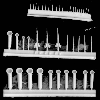| HISTORY |
|
| The fourth ship to bear the name New
York was an armored cruiser commissioned in August 1893. She was assigned
to the South Atlantic Squadron, and operated in the Caribbean and South
Atlantic in her early years. In 1895 she joined the European Squadron making
a port call represented the United States at the opening of the Kiel Canal.
She operated off the Atlantic coast for the next two years.
When war was declared on Cuba in 1898, New York bombarded defenses at
Matanzas. She joined the rest of the US fleet to hunt for the Spanish fleet
and later joined in the bombardment of San Juan. New York served as flagship
of Admiral Sampsonís squadron as he destroyed the Spanish fleet at the
battle of Santiago. For the next few years New York operated in this area.
In 1901 she was transferred to the Asiatic Fleet and operated from Yokohama
to the Philippine islands. New York visited Hong Kong and other Chinese
ports in 1902 before returning stateside by way of Vladivostok, Russia,
and Korea before making San Francisco to honor President Roosevelt.
In 1903 she was transferred to the Pacific Squadron and operated up
and down the coast of Central and South America protecting American interests.
In 1905 she sailed for Boston for modernization. she rejoined the Asiatic
Fleet arriving in Manila August of 1910. In February 1911 she was renamed
Saratoga to allow the name New York to be assigned to the new battleship
to be laid down that year.
As Saratoga, she operated in the Far East before returning stateside
and being placed in reduced commission with the Pacific reserve fleet at
Bremerton. When US involvement in World War I became immanent, Saratoga
returned to active duty with the Pacific Patrol Force. She operated off
Mexico intercepting and helping to capture a ship transporting German agents.
Later in 1917 she passed through the Panama Canal to join the Atlantic
Fleet at Hampton Roads as part of the Cruiser Force. By the end of the
year she again lost her name to make way for another planned warship, this
time a carrier. She was renamed Rochester and served as an escort for convoys
across the Atlantic for the remainder of the war. After the war, she transported
troops home. Rochester continued to serve until finally decommissioning
in April 1933 at Cavite in the Philippines. She survived until the start
of World War II when she was scuttled to prevent her capture by the Japanese.
This new kit by Niko has been made possible through the efforts of Pacific
Front Hobbies. It represents the ship as built to her first modernization
in 1905.
|
| HULL |
|
| The hull is well cast waterline style. The gun ports are
cast onto the sides along with other details. If the gun ports look a little
plain, don't worry there are photo etch panels that go over them for better
detail. The deck is nicely planked and features recesses for the separate
deck details. |
click images
to enlarge
|
 |
|
|
| SUPERSTRUCTURE AND FUNNEL |
|
| The funnels are one piece with the ends slightly hollowed out and exterior
piping. The main gun turrets are cast as a single part with separate gun
barrels. A resin bridge is included, but you also have a PE option if you
want more detail. |
 |
|
|
| GUNS, AND VENTS |
|
| Main guns and gun barrels are provided in resin. The various vents
pipes are well cast with hollow openings. |
 |
|
|
| SHIPS BOATS |
|
| A variety of boats are provided nicely cast with nice surface detail. |
 |
|
|
| ANCHORS, BITS, AND SMALL PARTS |
|
| Anchors and winches and a variety of fittings are provided cast on
resin runners. The small bits will help the kit to stand out. |
 |
|
|
| DECKS |
|
| The upper decks are cast on a thin resin wafer with nice planking detail.
These are very thin with only a trace of flash to trim away. |
 |
|
|
| PHOTO ETCH |
|
| A relief etched stainless steel fret provides the railings, davits,
and gun port panels. As mentioned above new decks and bridge walls are
provided for those who want the additional detail and would rather not
use the solid resin parts. |
 |
|
|
| Lengths of 2 mm and 4 mm rod are included to fabricate the mast parts
and other details. Photo etched boat oars will add some extra detail to
the ships boats. |
 |
|
| INSTRUCTIONS |
|
| The instructions are six pages with a mix of photos showing
the assembly in steps. They are pretty extensive and include a finished
plan and elevation of the assembled ship. The last page includes a color
view of the ship with Hobby Color paint call-outs.
|
| CONCLUSIONS |
|

This is an impressive kit of one of the lesser known cruisers from
the Navy's early years. It is perfect for the Spanish-American war fleet.
This is the US
Navy Armored Cruiser New York, ACR-2, 1899 (Niko 1:700 Resin) offered
exclusively by Pacific
Front Hobbies for $79.95 US. Bravo Zulu to Brandon Lowe and the team
at Pacific Front/Freetime Hobbies for making this kit possible. |





